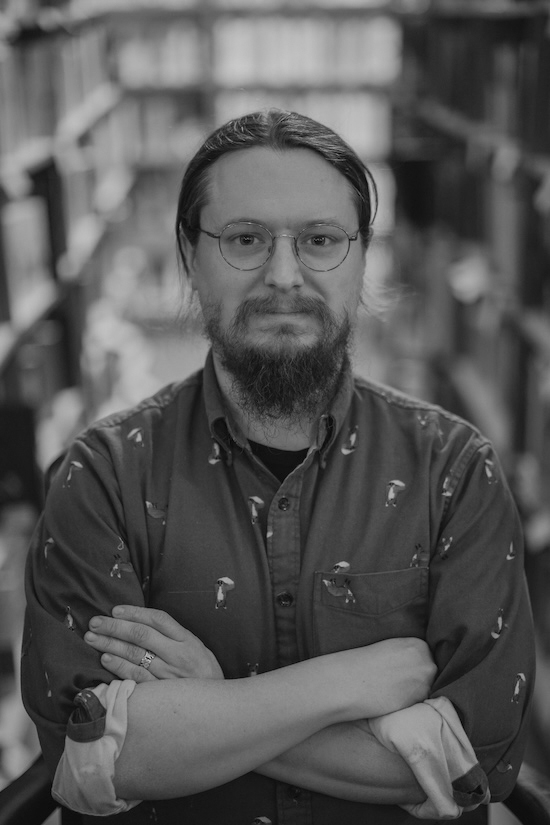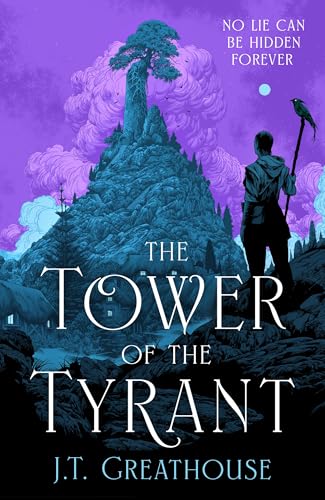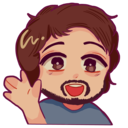Some Thoughts with ... J.T. Greathouse
5 Nov 2025The Author/s

J.T. Greathouse
J.T. Greathouse has been writing fantasy and science fiction since he was eleven years old. He holds a BA in history and philosophy with a minor in Asian studies as well as a Master’s in Teaching from Whitworth University, and spent four months of intensive study in Chinese language and culture at Minzu University in Beijing (中山民族大学, Zhongshan Minzu Daxue).
His short fiction has appeared, often as Jeremy A. TeGrotenhuis, in Beneath Ceaseless Skies, Writers of the Future 34, Deep Magic, Orson Scott Card’s Intergalactic Medicine Show, and elsewhere. In addition to writing, he has worked as an ESL teacher in Taipei, as a bookseller at Auntie’s Bookstore in Spokane, and as a high school teacher. He currently lives in Spokane, Washington with his wife Hannah and several overflowing bookshelves.
The Interview
1.- Could you introduce yourself to Jamreads’ readers?
Gladly! I’m J.T. Greathouse, a fantasy author (obviously) published by Gollancz in the UK and Commonwealth territories. I self-publish my books with help from my agency, JABberwocky, in the U.S. and elsewhere. I’ve been a fan of genre fiction for basically my whole life, ever since my dad showed me the original Star Wars trilogy when I was five years old. I proceeded to become obsessed with the Redwall and Animorphs series when I was in primary school, then the Lord of the Rings, Dune, the Wheel of Time, the Earthsea Cycle, various anime and manga (Fullmetal Alchemist and the Gundam franchise are particular favorites) and so on and so forth. Beyond fandom stuff, I’m also fascinated by history and philosophy, and spent my undergraduate education focused on religion and philosophy in Ming and Qing dynasty China. After a stint teaching abroad in Taiwan, I moved back to the United States, worked in an independent bookstore for a few years, and now teach secondary English and History.
2.- When did you start writing fiction?
I’ve always enjoyed making up stories, but the format changed as I grew up. As a tiny kid it was all imaginative play, then I started drawing lots of comics, and I became interested in writing stories when I was about eleven years old. I very distinctly remember writing a piece of Redwall fanfiction about a family of river shrews about that time. My mom was an English teacher and ran creative writing workshops that I participated in, too. When I was fifteen I entered a local writing contest for students in my home town with encouragement from my mom and my English teacher, and I wound up winning my division. A feat I repeated again the following two years. Those early successes were what really motivated me to make writing my creative focus. I started taking it more seriously and trying to get published when I was in college, but didn’t manage to sell any fiction until I was in my mid-twenties.
3.- Your first published series was Pact and Pattern. Could you tell us a bit of the idea behind it?
The Pact and Pattern books are basically about two things. First, they’re about the pressures that colonialism imposes on the colonized. This was based in some reading I did in college of Edward Said’s Orientalism and a book called Imagined Communities by Benedict Anderson, both of which, in part, deal with the way in which the literati of colonized peoples often end up “conscripted” by the colonizers to serve the colonial interest. The plot arc of the first book, The Hand of the Sun King, is largely about that idea, exploring it through a coming-of-age fantasy novel about a kid who grows up on a colonized island and ends up serving the colonial Empire in order to learn magic. But of course this goes badly for him.
The second and third books explore slightly different, but related ideas that tie into what I perceive as a fundamental philosophical conflict between control and acceptance. On the one hand, you have religious and philosophical traditions like Confucianism or Catholicism or Kantian Deontology that focus on structured, systemic order as a way of achieving stability and moral certainty. On the other hand, you have traditions like Taoism, or Charismatic Protestantism, or Existentialism that reject hierarchy and structure from the belief that it actually puts people out of sync with deeper truths of the universe. As human beings, we are afraid of chaos, and use structure to make ourselves feel more secure. But what about when the structures themselves create chaos, or violence, or insecurity? Where do we turn to then? The Garden of Empire, the second Pact and Pattern book, explores all of this in the context of war and revolution. The structure (the empire) is recognized as bad, but what is the cost of replacing it? The Pattern of the World, the third and final book in the series, deals with it more metaphysically, on the level of the magical structures and systems that exist within the world itself.
This makes them sound very heady, and they are a bit philosophical, but they’re also stories about youthful mistakes, rebellion, and redemption, and about the idea that at the end of it all the only thing worth fighting for is peace and normalcy.
4.- Did you have the full trilogy drafted before it was submitted, or were you working on the later books while the first one was being published?
I had The Hand of the Sun King drafted before I sought out an agent, and I knew how I wanted the series to end, but I didn’t know how I would get there until I started writing The Garden of Empire. I’m largely a discovery writer, so I don’t tend to write extensive outlines. Most of the fun of writing is in figuring out what the story I’m telling even is!
5.- The Tower of the Tyrant is your newest work. How would you define it?
As an epic about history, suppression, and the sacrifices people will make to feel safe in a chaotic world. Also about how the past always comes back to haunt us, no matter how we try to bury it, about how cool it would be to have a magical bird that can provide for all of your material needs, and about how intensely cool (and, from certain perspectives, intensely sexy) a seven-foot tall dude with four arms who is preternaturally good at archery would be.
6.- Would you say the focus changes when you are drafting a standalone versus an entire trilogy?
For one thing, as a discovery writer, I was able to revise the entire project all at once instead of working on it one piece at a time. The Hand of the Sun King was out before I even started drafting The Pattern of the World, and that led to a dynamic where certain things were “locked” before I got to that part of the story. Not that I would have changed much, but there were certain decisions that I couldn’t go back and change even if I had wanted to, because people had already read HotSK. For another, part of the fun, and the burden, of writing a standalone is making the book feel self-contained without it feeling stifling. At the beginning of a trilogy you can leave a lot of things open-ended. Book one of a series is usually composed of as many dangling threads as tied-off plot points. With a standalone, if you introduce a concept to the story, it needs to serve some kind of purpose in that volume, it can’t just exist to seed interest in what might be coming later. I am planning to write more books in the same world as The Tower of the Tyrant, so I can leave a few things dangling at the worldbuilding level (like mysteries about the First Folk, or what the deal is with the Fae or the Fiends, and so on) but all of the actual plotlines in the book needed to come to some kind of conclusion.
7.- It is interesting to see the clash between factions over a land they are foreign to; is the conflict between the City and the Inquisition shaped by any real/historical one?
There are all kinds of examples of this sort of thing in history! You’ve got the 20th century proxy wars during the Cold War, where Russia and the US didn’t fight directly, but did send arms and funding to different guerilla groups that opposed each other’s interests. Then there’s the Colonial Era wars between the European powers, which were largely fought at sea or in the Americas or Africa. Heck, one of the major theaters of World War II was between European powers in North Africa! Then going back further, you have the Crusades, which were partially religious conflicts over holy sites, and partially economic conflicts over control of trade routes. There wasn’t any specific historical example I drew on for The Tower of the Tyrant, but the idea that the Mortal Church would try to take advantage of Parwys’ current crisis to expand their influence is the classic move of a colonial power.
8.- The Tower of the Tyrant is a quite ambitious book, with many pieces moving at the same time. How did you manage to keep everything in order?
Not to be overly boastful, but I am very good at holding lots of things in my head all at the same time. I was discovery-writing the book, so in the first draft phase I just kept plowing ahead, one chapter at a time, building up the story as I went. At any given point while drafting I knew what each character or faction was trying to achieve, how the other characters were at cross purposes or aligned with them, and what the next move of each person or faction was likely to be. I didn’t always know where exactly things were going, though.
After I finished the first draft, I went back through the book and made a timeline of events and an outline of story beats just to make sure everything hung together and made sense, and I did wind up adjusting some dates and times, but mostly it worked out! I’m not sure if that’s luck, good intuition, or if I’ve hit that 10,000 hour point Malcolm Gladwell talked about in Outliers.
9.- Is there a particular character you enjoyed writing?
Everyone in this book was super fun to write. Fola’s odd perspective on the world was very delightful, and I made myself laugh out loud at a certain gag where she entirely disregards common sense about the value of money and how much she ought to tip. Llewyn has some of the most heart-breaking stuff in the book, and I found his dynamic with Siwan really interesting to explore. My favorite, though, was Torin, oddly enough. I like villains who see themselves as protagonists, and that describes Torin perfectly. He’s just such a vile jerk, and so totally oblivious to his own vileness.
10.- What other pieces of media would you recommend to people that enjoyed The Tower of the Tyrant?
If you like the Fantasy x Mystery setup, I’d recommend The Tainted Cup by Robert Jackson Bennet, Voyage of the Damned by Frances White, and the Empire of the Wolf trilogy by Richard Swan.
If you were into the utopian anarchism of it all and want more of that, check out the Culture series by Iain M. Banks. The concept behind The City of the Wise was literally to plonk Banks’ Culture into the middle of a grimdark fantasy world. Consider Phlebas is the first book, but it’s a series of standalones (largely) and I recommend starting with either Use of Weapons or The Player of Games. You might also read. . . well, basically anything by Ursula K. Le Guin, but The Dispossessed and The Telling were the most influential on this book.
If you want more Llewyn and Siwan, they are very (obviously) inspired by the dynamic of Geralt and Ciri in the Witcher novels by Andrej Sapkowski, and the fabulous The Witcher 3 from CD Project Red, which might be my favorite video game of all time.
And if you’re really into the weird mystery of a bunch of magic stuff left behind by a vanished civilization, The Wheel of Time series by Robert Jordan was what first got me into that whole concept, but I’m actually an even bigger fan of the Numenera RPG system from Monte Cook games. Check out Torment: Tides of Numenera for a video game using that system and setting.
11.- What can we expect from J.T. Greathouse in the future?
I’m contracted with Gollancz for two more standalones in the same world as The Tower of the Tyrant. The first of those is with my editor now, and will hopefully be coming out around this time next year. It starts with a very brutal and public murder in the City of the Wise itself, which prompts the question - how did someone get murdered in a utopia where death is impossible? The plot of the book is an investigation into that question, and then some chaos once the answer starts becoming clear.
Beyond that, I have some other stuff I’m working on or want to work on, but none of it is official yet. I’m posting stuff mostly on Blusky (@jeremyteg.bsky.social) and Instagram (@jeremytegauthor) these days, so follow me there for news! I’m also planning to start some kind of newsletter of my own eventually, but that doesn’t exist yet, and the best way to learn about it will be from my social media!

The Tower of the Tyrant is the most recent standalone novel written by J.T. Greathouse. If you are inclined, here's a link to get a copy.
